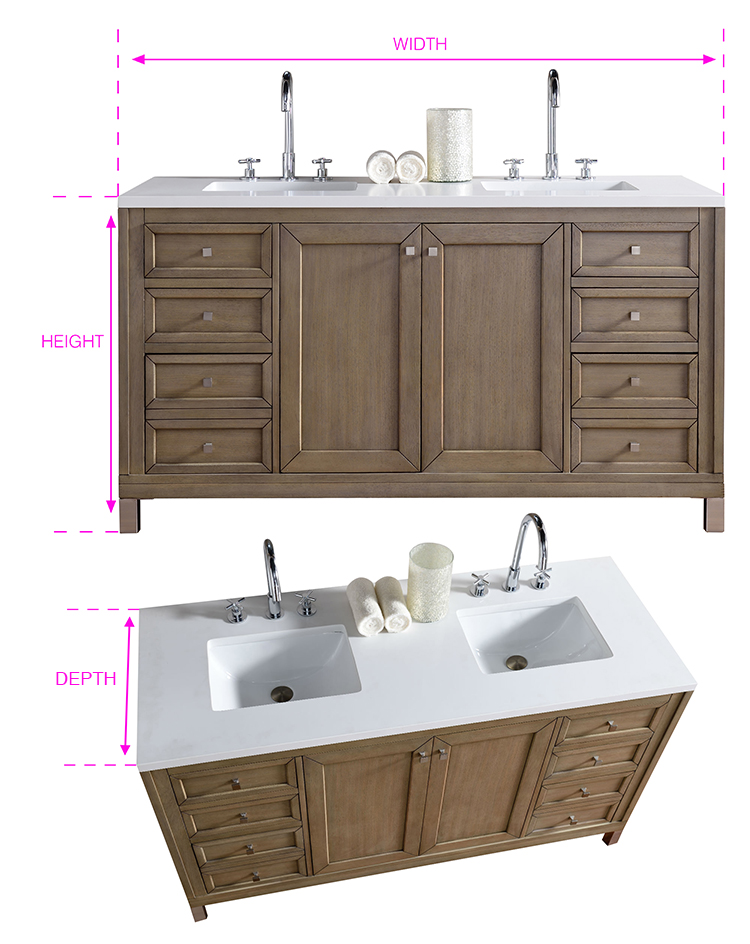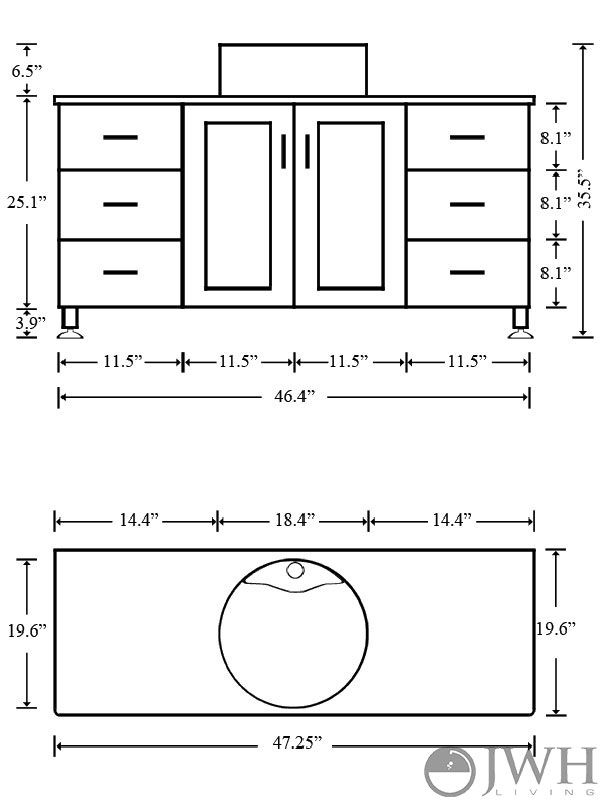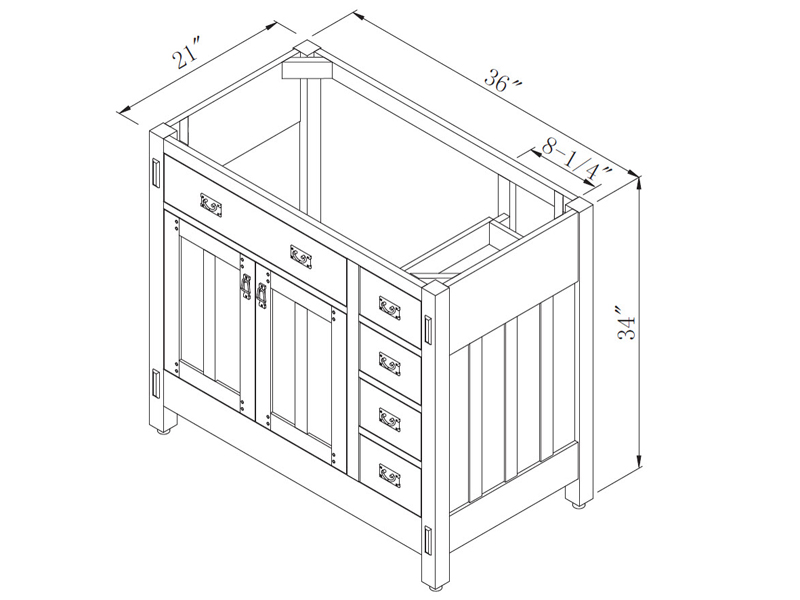Bathroom Vanity Cabinet Depth
Why Cabinet Depth Matters in a Bathroom Vanity
When I started planning my bathroom renovation, I quickly realized how important cabinet depth is in a bathroom vanity. At first glance, it seemed like a minor detail, but after digging deeper, I understood how much it can impact storage, functionality, and even the overall flow of the room. Here’s why cabinet depth should be a top consideration in any bathroom design.
- Storage Capacity
Cabinet depth plays a major role in how much storage you have. A vanity that’s too shallow won’t provide enough room for everyday essentials, like towels, toiletries, or cleaning supplies. On the other hand, a deeper vanity offers more storage space but may take up more floor space, which can be tricky in a smaller bathroom. - Accessibility
The depth of your vanity can make or break how easy it is to access the items stored inside. Shallow cabinets are great for quickly grabbing what you need, while deeper cabinets may require some digging to reach the back. I’ve found that organizing deeper cabinets with pull-out drawers or shelves can help solve this issue, making them more user-friendly. - Space Planning
Cabinet depth also affects how much space is left in the rest of your bathroom. A deep vanity can make a small bathroom feel cramped, leaving little room to move around. Conversely, a shallow vanity opens up the space, giving you more room to breathe. I had to carefully balance depth and floor space in my own bathroom to keep it feeling open and airy. - Sink Size and Positioning
One thing I didn’t initially consider was how cabinet depth impacts the size and positioning of the sink. A shallow vanity might limit your sink options, while a deeper one can accommodate larger, more luxurious sinks. In my experience, getting the right balance between sink and cabinet depth is key for both functionality and aesthetics. - Plumbing Considerations
Plumbing is another factor that’s directly tied to cabinet depth. Deeper vanities often provide more space to hide plumbing, while shallow vanities can make it difficult to conceal pipes, which may disrupt the look of the room. In my case, I had to make sure the depth I chose could adequately hide all the plumbing without limiting storage space. - Bathroom Layout
Finally, I found that cabinet depth influences the overall layout and flow of the bathroom. A deep vanity can dominate the room, especially in smaller spaces, while a shallow vanity keeps the layout feeling more spacious. I had to weigh how much depth I needed against the rest of the room’s design to ensure everything fit together seamlessly.

Standard Bathroom Vanity Cabinet Depth: What to Expect
When I first started shopping for bathroom vanities, I quickly learned that there’s a standard depth for most cabinets. This “default” depth is something you’ll come across often, but it’s not always a one-size-fits-all solution. Knowing what to expect can help you decide if you want to stick with the standard or customize your vanity to better fit your space.
Typical Depth Range
The standard depth for most bathroom vanities falls between 18 and 21 inches. I found that this size works well for a variety of bathroom layouts, offering enough storage space while still being compact enough to fit in smaller bathrooms. If you’re not dealing with a particularly tight space, the standard depth is usually a safe bet.
Balancing Storage and Space
At 21 inches deep, the vanity provides a good balance between storage and bathroom floor space. I had enough room to store essentials like towels, hair dryers, and toiletries without feeling like the vanity was taking over the room. However, if you’re looking for even more storage, you might want to explore deeper options.
Common Sink Compatibility
Another benefit of the standard depth is that it’s designed to accommodate most bathroom sink styles. Whether you prefer an under-mount, vessel, or drop-in sink, the standard depth offers enough room to install a variety of sinks without crowding the countertop. I liked that this made the design process simpler since I didn’t have to worry too much about fitting the sink.
Countertop Space
While the depth impacts what’s stored inside the cabinet, it also affects the countertop space above. I found that a 21-inch vanity gave me enough countertop space for daily items like soap dispensers, toothbrush holders, and even a little decor. If you’re someone who likes to keep things on the counter, this depth provides just enough surface area.
Ideal for Medium-Sized Bathrooms
Standard-depth vanities are typically ideal for medium-sized bathrooms. They provide enough storage for a family bathroom or guest bath without overwhelming the space. In my experience, they fit well in most bathroom layouts and don’t require too much customization, making them a convenient and versatile choice.
Options for Smaller Bathrooms
If you’re working with a smaller bathroom, the standard depth might feel a bit too bulky. In this case, opting for a vanity that’s closer to 18 inches in depth can help save space. While you’ll sacrifice some storage, I found that using vertical storage solutions, like wall-mounted shelves, can help make up for the loss of cabinet space.

Pros and Cons of Shallow Vanity Cabinets
When I was remodeling my smaller bathroom, I quickly realized that a shallow vanity cabinet might be the best option for saving space. But before committing, I weighed the pros and cons to make sure it would still offer the functionality I needed. Here’s what I learned from my research and personal experience.
Pro: Saves Floor Space
The biggest advantage of a shallow vanity is how much floor space it saves. In my small bathroom, every inch counted, and opting for a vanity with a depth of 16 to 18 inches opened up the room. I had more space to move around, and the bathroom felt less cramped overall.
Pro: Easier Access to Stored Items
Shallow vanities make it much easier to reach items stored inside. I loved that I didn’t have to dig through the back of the cabinet to find what I needed. Everything was within easy reach, which made organizing toiletries and bathroom essentials a breeze.
Con: Limited Storage Space
The downside to a shallow vanity is the reduced storage capacity. While I didn’t need to store a ton of items in my bathroom, I did notice that the shallow cabinet couldn’t hold as much as a deeper one. If you have a lot of bathroom essentials, you might need to look for additional storage solutions, like wall-mounted cabinets or shelves.
Pro: Works Well in Tight Spaces
Shallow vanities are perfect for tight spaces like powder rooms or guest bathrooms. I found that the smaller footprint allowed me to keep the bathroom functional without feeling cramped. It’s a great option if you’re dealing with a narrow layout or limited square footage.
Con: Limited Sink Options
One thing I didn’t consider initially was how the shallow depth would impact my sink choice. I had fewer options when it came to sink size, as a larger or deeper sink would either not fit or look out of proportion. In the end, I went with a compact, shallow sink that matched the vanity, but it’s something to keep in mind.
Pro: Budget-Friendly
Shallow vanities tend to be more affordable than their deeper counterparts. Since they use less material and are often smaller in size, I noticed a significant price difference when comparing shallow vanities to standard or deeper ones. If you’re working within a budget, this can be a great way to save money without sacrificing style.
Deep Bathroom Vanity Cabinets: Maximizing Storage Space
When I was planning the master bathroom renovation, one of my top priorities was storage. A deep bathroom vanity cabinet seemed like the perfect solution. If you’re someone who values having plenty of storage in the bathroom, a deeper vanity can be a game-changer. Here’s how it worked for me.
Pro: Ample Storage Capacity
One of the main reasons I chose a deeper vanity cabinet—at around 24 inches—was the added storage space. I loved how much more room it provided for all my bathroom essentials. Towels, toiletries, and even cleaning supplies had a place inside the cabinet, and I didn’t have to worry about overcrowding.
Pro: Great for Larger Bathrooms
If you’re working with a larger bathroom, a deep vanity is ideal. I found that it filled the space nicely, giving the room a more substantial and luxurious feel. The deeper cabinet provided not just storage, but a sense of balance in the overall design, especially in a spacious bathroom.
Con: Takes Up Floor Space
The downside to a deeper vanity is that it takes up more floor space. While this wasn’t an issue in my larger bathroom, it could be problematic in smaller bathrooms. It’s something to consider if you’re working with limited space, as a deep cabinet might make the room feel cramped.
Pro: Enhanced Countertop Space
In addition to more storage inside the cabinet, a deeper vanity also gives you more countertop space. I loved having the extra surface area to place bathroom essentials, decorations, and even a small plant. The extended countertop made the vanity feel more functional and less cluttered.
Con: Harder to Reach the Back of the Cabinet
While the extra storage was great, I did notice that it could be harder to access items at the back of the deep cabinet. I had to get creative with storage solutions, like adding pull-out drawers or baskets, to make sure everything was easy to reach. It’s a trade-off worth considering if you don’t want to constantly be digging for items.
Pro: Better Sink Compatibility
One of the unexpected benefits of a deeper vanity was the variety of sink options I had. I was able to choose a larger sink without worrying about it taking up too much space. The depth allowed for a wider range of sink sizes, which gave me more flexibility in the overall design.
Choosing the Right Cabinet Depth for Small Bathrooms
When it comes to small bathrooms, cabinet depth becomes one of the most important factors in the design process. I learned this firsthand while renovating a tiny guest bathroom. Finding the right balance between storage and space-saving was crucial, and the depth of the vanity played a major role in achieving that balance.
Consider Your Floor Space
In a small bathroom, every inch of floor space counts. I quickly realized that a standard-depth vanity would take up too much room, leaving little space to move around. Instead, I opted for a vanity with a shallower depth—about 16 to 18 inches—which made the bathroom feel more open and accessible.
Maximize Vertical Storage
Since I couldn’t rely on a deep vanity for storage, I had to think vertically. Wall-mounted cabinets, floating shelves, and even over-the-toilet storage helped make up for the reduced cabinet space. This approach allowed me to keep the vanity shallow without sacrificing too much storage.
Don’t Sacrifice Functionality
One of my biggest concerns was that a shallow vanity wouldn’t be functional enough. However, by carefully choosing the right size and organizing it well, I found that even a shallow cabinet could be just as practical as a deeper one. It forced me to declutter and focus on storing only what I really needed in the bathroom.
Choose a Compact Sink
With a shallow vanity, I had to be mindful of the sink size. A large, deep sink would have overwhelmed the space, so I went with a compact, under-mount sink that fit perfectly with the vanity’s depth. This not only saved space but also maintained a sleek, streamlined look in the bathroom.
Look for Slim Profiles
I found that some vanities are specifically designed for small bathrooms and feature slim profiles that still offer plenty of storage. These vanities often have pull-out drawers or built-in shelves that maximize storage in a shallow space. It’s worth exploring these options if you’re working with limited square footage.
Keep the Design Minimal
In a small bathroom, less is often more. I chose a minimal design for the vanity, which helped make the room feel larger. Clean lines, simple hardware, and a neutral color scheme kept the space from feeling cluttered, even with a shallower cabinet.

Customizing Vanity Cabinet Depth for Unique Spaces
When I was remodeling my bathroom, I realized that a standard vanity depth wouldn’t work for my unique space. That’s when I started exploring the idea of customizing the cabinet depth to fit my specific needs. Customizing your vanity’s depth can be a game-changer, especially if you’re working with an oddly shaped bathroom or specific storage needs.
Tailoring to Your Space
One of the first things I did was measure my bathroom carefully to see how much depth I could afford. I had a narrow layout that required a shallower vanity on one side of the bathroom, but I also had room for a deeper vanity on the other side. Customizing the depth allowed me to make the most of the available space.
Combining Shallow and Deep Cabinets
Another approach I considered was mixing shallow and deep cabinets in the same vanity. This combination allowed me to maximize storage in some areas while keeping the overall footprint compact. It’s a great option if you want to balance depth without sacrificing functionality or storage.
Choosing a Depth Based on Storage Needs
Customizing the depth also allowed me to tailor the vanity to my specific storage needs. I didn’t need deep cabinets for everything, but for larger items like towels and cleaning supplies, a deeper section was essential. By customizing, I could create storage that fit my lifestyle perfectly.
Accommodating Plumbing and Fixtures
Another reason I opted for a custom depth was to work around the plumbing. In my bathroom, the plumbing wasn’t in the ideal location, and a standard vanity wouldn’t have fit properly. Customizing the depth ensured that the cabinet could accommodate the pipes without sacrificing storage space or aesthetics.
Balancing Aesthetics and Functionality
One of the benefits of customizing vanity depth is that it allowed me to balance aesthetics and functionality. I was able to create a sleek, modern design that still provided plenty of storage. The customized depth made the vanity look proportional to the rest of the bathroom, which was important for the overall design.
Cost Considerations
While customizing the depth of a vanity can be more expensive than buying a pre-made option, I found that the benefits were worth the extra cost. The tailored fit, improved functionality, and enhanced design made the investment worthwhile. If you’re dealing with a unique space, the extra expense of customization can be a smart choice in the long run.

Impact of Cabinet Depth on Bathroom Functionality and Design
When I started thinking about cabinet depth, I didn’t realize how much it would influence both the functionality and design of my bathroom. It turns out that this small detail can make a big difference in how your bathroom looks and works on a day-to-day basis. Here’s what I discovered after installing a new vanity with a carefully chosen depth.
Functionality First
The depth of the vanity directly impacts how functional your bathroom is. A deeper cabinet provides more storage, but can also take up more space, making it harder to move around the bathroom. In my case, I had to balance the need for storage with the desire to keep the room feeling open and uncluttered.
Storage vs. Space
One of the biggest challenges I faced was deciding how much storage I needed. While a deep vanity offers more room for bathroom essentials, it can also dominate the room. I found that opting for a slightly shallower depth—around 20 inches—gave me enough storage while still leaving plenty of space to move around comfortably.
Aesthetic Impact
Cabinet depth also affects the overall look of the bathroom. A deep vanity can make the room feel more substantial and luxurious, while a shallow vanity creates a more streamlined, minimalist aesthetic. In my case, I wanted the vanity to be a focal point, so I went with a slightly deeper depth to give it more presence in the room.
Flow and Layout
One of the most important things I learned was how cabinet depth influences the flow and layout of the bathroom. A deep vanity can restrict movement, especially in a small bathroom, while a shallow vanity keeps the space feeling open. I had to carefully consider how the depth would affect the way we move around the room.
Sink and Fixture Compatibility
The depth of the vanity also dictates what kind of sink and fixtures you can install. I opted for a deeper vanity to accommodate a larger, more luxurious sink, which became a design feature in itself. If you’re considering a larger sink or elaborate fixtures, cabinet depth is something you’ll want to factor into your decision.
Long-Term Usability
Lastly, I realized that the depth of the cabinet plays a big role in the long-term usability of the bathroom. A vanity that’s too shallow might not provide enough storage, while one that’s too deep can become cumbersome. I found that choosing the right depth is essential for creating a bathroom that’s both beautiful and functional for years to come.

Bathroom Vanities Dimensions & Drawings
Bathroom Vanities Buy Bathroom Vanity Furniture

Related Posts: